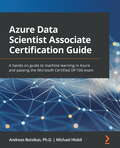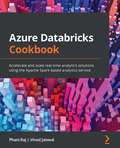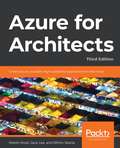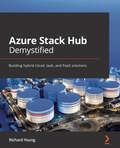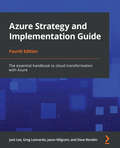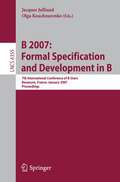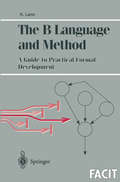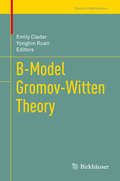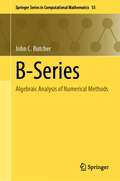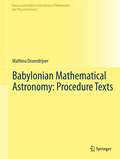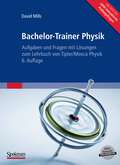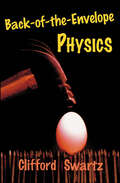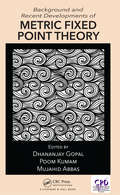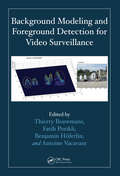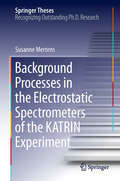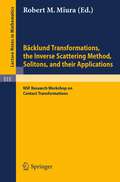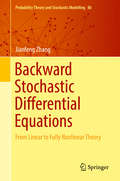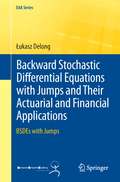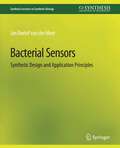- Table View
- List View
Azure Data Scientist Associate Certification Guide: A Hands-on Guide To Developing Machine Learning Skills And Passing The Microsoft Certified Dp-100 Exam
by Andreas Botsikas, Ph.D. and Michael HlobilA hands-on guide to machine learning in Azure and passing the Microsoft Certified DP-100 exam
Azure Databricks Cookbook (PDF): Accelerate And Scale Real-time Analytics Solutions Using The Apache Spark-based Analytics Service
by Phani Raj Vinod JaiswalGet to grips with building and productionizing end-to-end big data solutions in Azure and learn best practices for working with large datasets Key Features Integrate with Azure Synapse Analytics, Cosmos DB, and Azure HDInsight Kafka Cluster to scale and analyze your projects and build pipelines Use Databricks SQL to run ad hoc queries on your data lake and create dashboards Productionize a solution using CI/CD for deploying notebooks and Azure Databricks Service to various environments Book Description Azure Databricks is a unified collaborative platform for performing scalable analytics in an interactive environment. The Azure Databricks Cookbook provides recipes to get hands-on with the analytics process, including ingesting data from various batch and streaming sources and building a modern data warehouse. The book starts by teaching you how to create an Azure Databricks instance within the Azure portal, Azure CLI, and ARM templates. You'll work through clusters in Databricks and explore recipes for ingesting data from sources, including files, databases, and streaming sources such as Apache Kafka and EventHub. The book will help you explore all the features supported by Azure Databricks for building powerful end-to-end data pipelines. You'll also find out how to build a modern data warehouse by using Delta tables and Azure Synapse Analytics. Later, you'll learn how to write ad hoc queries and extract meaningful insights from the data lake by creating visualizations and dashboards with Databricks SQL. Finally, you'll deploy and productionize a data pipeline as well as deploy notebooks and Azure Databricks service using continuous integration and continuous delivery (CI/CD). By the end of this Azure book, you'll be able to use Azure Databricks to streamline different processes involved in building data-driven apps. What you will learn Read and write data from and to various Azure resources and file formats Build a modern data warehouse with Delta Tables and Azure Synapse Analytics Explore jobs, stages, and tasks and see how Spark lazy evaluation works Handle concurrent transactions and learn performance optimization in Delta tables Learn Databricks SQL and create real-time dashboards in Databricks SQL Integrate Azure DevOps for version control, deploying, and productionizing solutions with CI/CD pipelines Discover how to use RBAC and ACLs to restrict data access Build end-to-end data processing pipeline for near real-time data analytics Who this book is for This recipe-based book is for data scientists, data engineers, big data professionals, and machine learning engineers who want to perform data analytics on their applications. Prior experience of working with Apache Spark and Azure is necessary to get the most out of this book.
Azure For Architects: Create Secure, Scalable, High-availability Applications On The Cloud
by Ritesh Modi Jack Lee Rithin SkariaThanks to its support for high availability, scalability, security, performance, and disaster recovery, Azure has been widely adopted to create and deploy different types of application with ease. Updated for the latest developments, this third edition of Azure for Architects helps you get to grips with the core concepts of designing serverless architecture, including containers, Kubernetes deployments, and big data solutions. You'll learn how to architect solutions such as serverless functions, you'll discover deployment patterns for containers and Kubernetes, and you'll explore large-scale big data processing using Spark and Databricks. As you advance, you'll implement DevOps using Azure DevOps, work with intelligent solutions using Azure Cognitive Services, and integrate security, high availability, and scalability into each solution. Finally, you'll delve into Azure security concepts such as OAuth, OpenConnect, and managed identities. By the end of this book, you'll have gained the confidence to design intelligent Azure solutions based on containers and serverless functions.
Azure Stack Hub Demystified: Building Hybrid Cloud, Iaas, And Paas Solutions
by Richard YoungBuilding hybrid cloud, IaaS, and PaaS solutions
Azure Strategy And Implementation Guide: The Essential Handbook To Cloud Transformation With Azure, 4th Edition
by Greg Leonardo Jack Lee Jason Milgram Dave RendónThe essential handbook to cloud transformation with Azure
B 2007: 7th International Conference of B Users, Besancon, France, January 7-19, 2007, Proceedings (Lecture Notes in Computer Science #4355)
by Jacques Julliand Olga KouchnarenkoThis book constitutes the refereed proceedings of the 7th International Conference of B Users, B 2007, held in Besançon, France, January 2007. Coverage in this volume includes industrial applications and case studies using B, integration of model-based specification methods in the software development lifecycle, derivation of hardware-software architecture from model-based specifications, and validating requirements through formal models.
The B Language and Method: A Guide to Practical Formal Development (Formal Approaches to Computing and Information Technology (FACIT))
by Kevin LanoB is one of the few formal methods which has robust, commercially-available tool support for the entire development lifecycle from specification through to code generation. This volume provides a comprehensive introduction to the B Abstract Machine Notation, and to how it can be used to support formal specification and development of high integrity systems. A strong emphasis is placed on the use of B in the context of existing software development methods, including object-oriented analysis and design. The text includes a large number of worked examples, graduated exercises in B AMN specification and development (all of which have been class-tested), two extended case studies of the development process, and an appendix of proof techniques suitable for B. Based on material which has been used to teach B at postgraduate and undergraduate level, this volume will provide invaluable reading a wide range of people, including students, project technical managers and workers, and researchers with an interest in methods integration and B semantics.
B-Model Gromov-Witten Theory (Trends in Mathematics)
by Emily Clader Yongbin RuanThis book collects various perspectives, contributed by both mathematicians and physicists, on the B-model and its role in mirror symmetry. Mirror symmetry is an active topic of research in both the mathematics and physics communities, but among mathematicians, the “A-model” half of the story remains much better-understood than the B-model. This book aims to address that imbalance. It begins with an overview of several methods by which mirrors have been constructed, and from there, gives a thorough account of the “BCOV” B-model theory from a physical perspective; this includes the appearance of such phenomena as the holomorphic anomaly equation and connections to number theory via modularity. Following a mathematical exposition of the subject of quantization, the remainder of the book is devoted to the B-model from a mathematician’s point-of-view, including such topics as polyvector fields and primitive forms, Givental’s ancestor potential, and integrable systems.
B-Series: Algebraic Analysis of Numerical Methods (Springer Series in Computational Mathematics #55)
by John C. ButcherB-series, also known as Butcher series, are an algebraic tool for analysing solutions to ordinary differential equations, including approximate solutions. Through the formulation and manipulation of these series, properties of numerical methods can be assessed. Runge–Kutta methods, in particular, depend on B-series for a clean and elegant approach to the derivation of high order and efficient methods. However, the utility of B-series goes much further and opens a path to the design and construction of highly accurate and efficient multivalue methods. This book offers a self-contained introduction to B-series by a pioneer of the subject. After a preliminary chapter providing background on differential equations and numerical methods, a broad exposition of graphs and trees is presented. This is essential preparation for the third chapter, in which the main ideas of B-series are introduced and developed. In chapter four, algebraic aspects are further analysed in the context of integration methods, a generalization of Runge–Kutta methods to infinite index sets. Chapter five, on explicit and implicit Runge–Kutta methods, contrasts the B-series and classical approaches. Chapter six, on multivalue methods, gives a traditional review of linear multistep methods and expands this to general linear methods, for which the B-series approach is both natural and essential. The final chapter introduces some aspects of geometric integration, from a B-series point of view. Placing B-series at the centre of its most important applications makes this book an invaluable resource for scientists, engineers and mathematicians who depend on computational modelling, not to mention computational scientists who carry out research on numerical methods in differential equations. In addition to exercises with solutions and study notes, a number of open-ended projects are suggested. This combination makes the book ideal as a textbook for specialised courses on numerical methods for differential equations, as well as suitable for self-study.
Babylonian Mathematical Astronomy: Procedure Texts (Sources and Studies in the History of Mathematics and Physical Sciences)
by Mathieu OssendrijverThis book contains new translations and a new analysis of the procedure texts of Babylonian mathematical astronomy, the earliest known form of mathematical astronomy of the ancient world. The translations are based on a modern approach incorporating recent insights from Assyriology and translation science. The work contains updated and expanded interpretations of the astronomical algorithms and investigations of previously ignored linguistic, mathematical and other aspects of the procedure texts. Special attention is paid to issues of mathematical representation and over 100 photos of cuneiform tablets dating from 350-50 BCE are presented.In 2-3 years, the author intends to continue his study of Babylonian mathematical astronomy with a new publication which will contain new editions and reconstructions of approx. 250 tabular texts and a new philological, astronomical and mathematical analysis of these texts. Tabular texts are end products of Babylonian math astronomy, computed with algorithms that are formulated in the present volume, Procedure Texts.
Bachelor-Trainer Physik: Aufgaben und Fragen mit Lösungen zum Lehrbuch von Tipler/Mosca Physik 6. Auflage inclusive interaktive DVD zum Selbsttest
by David MillsDer Bachelor-Trainer zum Physiklehrbuch von Paul A. Tipler und Gene Mosca enthält die ausführlichen Lösungen zu allen in der sechsten deutschen Lehrbuchausgabe gestellten Aufgaben, und zwar in derselben Gliederung nach den Bereichen Mechanik, Schwingungen und Wellen, Thermodynamik, Elektrizität und Magnetismus, Licht und schließlich Moderne Physik (Quantentheorie, Relativitätstheorie und Struktur der Materie). Für Studenten bietet diese in sich geschlossene Aufgabensammlung mit Lösungen vielfältige Anregungen, um praxisnah und mit Blick auf Standardexperimente physikalisches Problemlösen mit Hilfe von ganz elementarem mathematischen Handwerkszeug zu entdecken, auszuprobieren und einzuüben - und zwar mit Spaß und Erfolgsgarantie! Denn die Lösungen werden schrittweise dargelegt.
Back-of-the-Envelope Physics
by Clifford SwartzPhysicists use "back-of-the-envelope" estimates to check whether or not an idea could possibly be right. In many cases, the approximate solution is all that is needed. This compilation of 101 examples of back-of-the-envelope calculations celebrates a quantitative approach to solving physics problems. Drawing on a lifetime of physics research and nearly three decades as the editor of The Physics Teacher, Clifford Swartz provides simple, approximate solutions to physics problems that span a broad range of topics. What note do you get when you blow across the top of a Coke bottle? Could you lose weight on a diet of ice cubes? How can a fakir lie on a bed of nails without getting hurt? Does draining water in the northern hemisphere really swirl in a different direction than its counterpart below the equator? In each case, only a few lines of arithmetic and a few natural constants solve a problem to within a few percent. Covering such subjects as astronomy, magnetism, optics, sound, heat, mechanics, waves, and electricity, the book provides a rich source of material for teachers and anyone interested in the physics of everyday life.
Back to Basics: The Education You Wish You'd Had
by Caroline TaggartDon't know Midas from Oedipus? Wouldn't recognize a concerto from a sonata? Many of us wish that we could fill in the gaps in our education in order to avoid those embarrassing situations when we feel as if we don't know things that others do. In Back to Basics, bestselling author Caroline Taggart will provide readers with the opportunity to learn really useful stuff that was never taught in mainstream education, while also giving a refresher course on the main staples. From brushing up on Bible stories and classical architecture, to identifying different types of clouds, your thirst for knowledge will be sated and your education complete - and it's enormous fun to boot!
Backdoor Attacks against Learning-Based Algorithms (Wireless Networks)
by Haojin Zhu Shaofeng Li Xuemin (Sherman) Shen Wen WuThis book introduces a new type of data poisoning attack, dubbed, backdoor attack. In backdoor attacks, an attacker can train the model with poisoned data to obtain a model that performs well on a normal input but behaves wrongly with crafted triggers. Backdoor attacks can occur in many scenarios where the training process is not entirely controlled, such as using third-party datasets, third-party platforms for training, or directly calling models provided by third parties. Due to the enormous threat that backdoor attacks pose to model supply chain security, they have received widespread attention from academia and industry. This book focuses on exploiting backdoor attacks in the three types of DNN applications, which are image classification, natural language processing, and federated learning.Based on the observation that DNN models are vulnerable to small perturbations, this book demonstrates that steganography and regularization can be adopted to enhance the invisibility of backdoor triggers. Based on image similarity measurement, this book presents two metrics to quantitatively measure the invisibility of backdoor triggers. The invisible trigger design scheme introduced in this book achieves a balance between the invisibility and the effectiveness of backdoor attacks. In the natural language processing domain, it is difficult to design and insert a general backdoor in a manner imperceptible to humans. Any corruption to the textual data (e.g., misspelled words or randomly inserted trigger words/sentences) must retain context-awareness and readability to human inspectors. This book introduces two novel hidden backdoor attacks, targeting three major natural language processing tasks, including toxic comment detection, neural machine translation, and question answering, depending on whether the targeted NLP platform accepts raw Unicode characters.The emerged distributed training framework, i.e., federated learning, has advantages in preserving users' privacy. It has been widely used in electronic medical applications, however, it also faced threats derived from backdoor attacks. This book presents a novel backdoor detection framework in FL-based e-Health systems. We hope this book can provide insightful lights on understanding the backdoor attacks in different types of learning-based algorithms, including computer vision, natural language processing, and federated learning. The systematic principle in this book also offers valuable guidance on the defense of backdoor attacks against future learning-based algorithms.
Background and Recent Developments of Metric Fixed Point Theory
This book focusing on Metric fixed point theory is designed to provide an extensive understanding of the topic with the latest updates. It provides a good source of references, open questions and new approaches. While the book is principally addressed to graduate students, it is also intended to be useful to mathematicians, both pure and applied.
Background Modeling and Foreground Detection for Video Surveillance
by Thierry Bouwmans Fatih Porikli Benjamin Höferlin Antoine VacavantBackground modeling and foreground detection are important steps in video processing used to detect robustly moving objects in challenging environments. This requires effective methods for dealing with dynamic backgrounds and illumination changes as well as algorithms that must meet real-time and low memory requirements.Incorporating both establish
Background Processes in the Electrostatic Spectrometers of the KATRIN Experiment (Springer Theses)
by Susanne MertensNeutrinos continue to be the most mysterious and, arguably, the most fascinating particles of the Standard Model as their intrinsic properties such as absolute mass scale and CP properties are unknown. The open question of the absolute neutrino mass scale will be addressed with unprecedented accuracy by the Karlsruhe Tritium Neutrino (KATRIN) experiment, currently under construction. This thesis focusses on the spectrometer part of KATRIN and background processes therein. Various background sources such as small Penning traps, as well as nuclear decays from single radon atoms are fully characterized here for the first time. Most importantly, however, it was possible to reduce the background in the spectrometer by more than five orders of magnitude by eliminating Penning traps and by developing a completely new background reduction method by stochastically heating trapped electrons using electron cyclotron resonance (ECR). The work beautifully demonstrates that the obstacles and challenges in measuring the absolute mass scale of neutrinos can be met successfully if novel experimental tools (ECR) and novel computing methods (KASSIOPEIA) are combined to allow almost background-free tritium ß-spectroscopy.
Bäcklund Transformations, the Inverse Scattering Method, Solitons, and Their Applications: Proceedings of the NSF Research Workshop on Contact Transformations, held in Nashville, Tennessee, 1974 (Lecture Notes in Mathematics #515)
by Robert M. MiuraProceedings of the NSF Research Workshop on Contact Transformations, Held in Nashville, Tennessee, 1974
Backseat Driver: The Role of Data in Great Car Safety Debates (ASA-CRC Series on Statistical Reasoning in Science and Society)
by Norma Faris HubeleBuying the safest car for your family shouldn’t be up for debate. Yet for decades, car safety advocates, manufacturers, and lawmakers in the United States have clashed over whether to make automobiles safer. All sides armed themselves with data in the hopes of winning the great car safety debates. In this way, crash statistics and the analysts who studied them made history. But data were always in the backseat, merely supporting different points of view. That is, until now. With car safety, it’s the value we place on every human life that counts. Automobile safety expert Dr. Norma Faris Hubele delivers a lively discussion of the role data play in protecting you and your family on the road. You’ll gain a greater appreciation for how: A World War I pilot’s near-death experience birthed the U.S. car safety movement Data from real car crashes helped create the first vehicle safety standards A shift toward fuel-efficient cars affected fatality risk in the 1970s–1980s versus now Vehicle size has changed, and the problems that creates for you and others sharing the road Car safety rating systems, even when limited, empower consumers and motivate manufacturers Federal regulators decide whether to issue a safety recall on your vehicle Data’s role is evolving with the advent of driver-assist and self-driving technologies
Backseat Driver: The Role of Data in Great Car Safety Debates (ASA-CRC Series on Statistical Reasoning in Science and Society)
by Norma Faris HubeleBuying the safest car for your family shouldn’t be up for debate. Yet for decades, car safety advocates, manufacturers, and lawmakers in the United States have clashed over whether to make automobiles safer. All sides armed themselves with data in the hopes of winning the great car safety debates. In this way, crash statistics and the analysts who studied them made history. But data were always in the backseat, merely supporting different points of view. That is, until now. With car safety, it’s the value we place on every human life that counts. Automobile safety expert Dr. Norma Faris Hubele delivers a lively discussion of the role data play in protecting you and your family on the road. You’ll gain a greater appreciation for how: A World War I pilot’s near-death experience birthed the U.S. car safety movement Data from real car crashes helped create the first vehicle safety standards A shift toward fuel-efficient cars affected fatality risk in the 1970s–1980s versus now Vehicle size has changed, and the problems that creates for you and others sharing the road Car safety rating systems, even when limited, empower consumers and motivate manufacturers Federal regulators decide whether to issue a safety recall on your vehicle Data’s role is evolving with the advent of driver-assist and self-driving technologies
Backward Stochastic Differential Equations: From Linear to Fully Nonlinear Theory (Probability Theory and Stochastic Modelling #86)
by Jianfeng ZhangThis book provides a systematic and accessible approach to stochastic differential equations, backward stochastic differential equations, and their connection with partial differential equations, as well as the recent development of the fully nonlinear theory, including nonlinear expectation, second order backward stochastic differential equations, and path dependent partial differential equations. Their main applications and numerical algorithms, as well as many exercises, are included. The book focuses on ideas and clarity, with most results having been solved from scratch and most theories being motivated from applications. It can be considered a starting point for junior researchers in the field, and can serve as a textbook for a two-semester graduate course in probability theory and stochastic analysis. It is also accessible for graduate students majoring in financial engineering.
Backward Stochastic Differential Equations with Jumps and Their Actuarial and Financial Applications: BSDEs with Jumps (EAA Series)
by Łukasz DelongBackward stochastic differential equations with jumps can be used to solve problems in both finance and insurance.Part I of this book presents the theory of BSDEs with Lipschitz generators driven by a Brownian motion and a compensated random measure, with an emphasis on those generated by step processes and Lévy processes. It discusses key results and techniques (including numerical algorithms) for BSDEs with jumps and studies filtration-consistent nonlinear expectations and g-expectations. Part I also focuses on the mathematical tools and proofs which are crucial for understanding the theory.Part II investigates actuarial and financial applications of BSDEs with jumps. It considers a general financial and insurance model and deals with pricing and hedging of insurance equity-linked claims and asset-liability management problems. It additionally investigates perfect hedging, superhedging, quadratic optimization, utility maximization, indifference pricing, ambiguity risk minimization, no-good-deal pricing and dynamic risk measures. Part III presents some other useful classes of BSDEs and their applications.This book will make BSDEs more accessible to those who are interested in applying these equations to actuarial and financial problems. It will be beneficial to students and researchers in mathematical finance, risk measures, portfolio optimization as well as actuarial practitioners.
Bacterial Circadian Programs
by Jayna L. Ditty Shannon R. Mackey Carl H. JohnsonSince the discovery of circadian rhythms in cyanobacteria in the late 1980s, the field has exploded with new information. The cyanobacterial model system for studying circadian rhythms, "Synechococcus elongatus", has allowed a detailed genetic dissection of the bacterial clock due to the methods currently available in molecular, structural, and evolutionary biology. This book addresses multiple aspects of bacterial circadian programs: the history and background of the cyanobacteria and circadian rhythms in microorganisms, the molecular basis, structure, and evolution of the circadian clock, entrainment of the oscillator with the environment and the control of downstream processes by the clock, the demonstration of adaptive significance and the prokaryotic clock’s remarkable stability, and mathematical and synthetic oscillator models for clock function. Experts in the field provide a timely and comprehensive review and a stepping-stone for future work on this amazing group of microorganisms and timing.
Bacterial Sensors: Synthetic Design and Application Principles (Synthesis Lectures on Synthetic Biology)
by Jan Roelof MeerBacterial reporters are live, genetically engineered cells with promising application in bioanalytics. They contain genetic circuitry to produce a cellular sensing element, which detects the target compound and relays the detection to specific synthesis of so-called reporter proteins (the presence or activity of which is easy to quantify). Bioassays with bacterial reporters are a useful complement to chemical analytics because they measure biological responses rather than total chemical concentrations. Simple bacterial reporter assays may also replace more costly chemical methods as a first line sample analysis technique. Recent promising developments integrate bacterial reporter cells with microsystems to produce bacterial biosensors. This lecture presents an in-depth treatment of the synthetic biological design principles of bacterial reporters, the engineering of which started as simple recombinant DNA puzzles, but has now become a more rational approach of choosing and combining sensing, controlling and reporting DNA 'parts'. Several examples of existing bacterial reporter designs and their genetic circuitry will be illustrated. Besides the design principles, the lecture also focuses on the application principles of bacterial reporter assays. A variety of assay formats will be illustrated, and principles of quantification will be dealt with. In addition to this discussion, substantial reference material is supplied in various Annexes. Table of Contents: Short History of the use of Bacteria for Biosensing and Bioreporting / Genetic Engineering Concepts / Measuring with Bioreporters / Epilogue
Bad Breaks in Real GDP and Employment: Exploring the Persistence of Aggregate Demand Shocks in the United States
by Harrison C. HartmanWhy do policymakers allow economies to settle into a “new normal” after a bad break in the economy rather than try to return the economy to its previous trend? In this book, economist Harrison C. Hartman discusses some of the variables that impact a nation’s ability to recover from negative aggregate demand shocks. Spanning total real GDP, per capita real GDP, and nonfarm payroll employment in the USA, the book emphasizes the role of aggregate demand shocks in causing the US economy to fail to return to trend. The resulting book challenges modern mainstream macroeconomic theories and highlights the complexities of post-recession recovery. The chapters provide econometric evidence both for and against the impact of aggregate demand on real GDP and employment levels in the long run. Hartman studies modern macroeconomic theories related to economic resilience and demand using (a) the velocity of money and the equation of exchange and (b) econometric analysis to dissect modern macroeconomic theories related to economic resilience and demand. The book provides methods to estimate and evaluate trends, and after simple methods for estimating trend and discussing associated results, the book turns attention to model selection, hypothesis testing and further results. This book also offers some possible areas for future work. A thought-provoking exploration of economic recovery or lack thereof, the book covers aggregate demand, employment, real GDP, and economic theories (classical, Keynesian, monetarist, neoclassical, new-Keynesian, and post-Keynesian perspectives). Bad Breaks in Real GDP and Employment is a timely and essential guide for economists navigating the complexities of past, present, and future macroeconomic landscapes. It explains the functionality of aggregate demand in the context of economic recession, offering insight into why some AD shocks feel permanent. This book provides econometric evidence supporting Keynesian and post-Keynesian perspectives on the potential importance of aggregate demand in determining real GDP and employment levels in the long run, particularly in cases when real GDP and employment fail to recover fully after recessions. This book is one of few contemporary works (a) explicitly noting the economic importance of money velocity and (b) focusing on econometric analysis that at least at times supports post-Keynesian perspectives.
